Best Tourist Spots in Budapest 2025: Local’s Guide

Budapest, the vibrant capital of Hungary, is a city where rich history, stunning architecture, and a unique cultural tapestry come together seamlessly.
Whether you are a history enthusiast, an architecture aficionado, or simply a traveler eager to explore a dynamic destination, Budapest offers something for everyone.
From the majestic spires of St. Stephen’s Basilica to the serene beauty of Margaret Island, and from its renowned thermal baths to the iconic Chain Bridge spanning the Danube River, this city is a treasure trove of landmarks waiting to be discovered.
Each landmark tells its own story, reflecting Budapest’s complex history, cultural heritage, and modern-day charm. This guide highlights best tourist spots in budapest, making this city a must-visit destination for travelers worldwide.
Budapest’s Architectural Marvels and Historical Edifices
Buda Castle: A Historical Crown Jewel
Buda Castle, perched atop Castle Hill, is one of Budapest’s most iconic landmarks and a testament to the city’s rich historical tapestry.
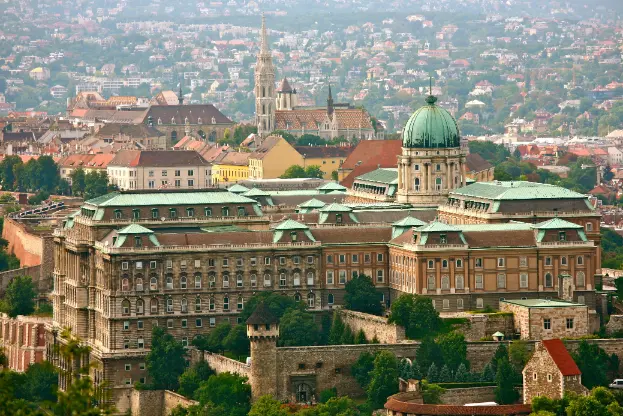
This UNESCO World Heritage Site boasts a history spanning centuries, from its medieval origins in the 13th century to its current status as a cultural and historical hub.
The castle’s architecture is a harmonious blend of Gothic, Renaissance, and Baroque styles, reflecting the various periods of its construction and reconstruction.
Under the Habsburg dynasty, the castle underwent extensive reconstruction, guided by the principles of Baroque architecture, which gave it its distinctive domes and elegant facades.
Parliament Building: Gothic Grandiosity on the Danube
The Hungarian Parliament Building, located in the heart of Budapest, is an architectural masterpiece that dominates the city’s skyline.

This grand structure, completed between 1884 and 1904, is a prime example of Neo-Gothic architecture, with its imposing facade, intricate stone carvings, and soaring spires.
The building’s design reflects the eclectic architectural style of the 19th century and symbolizes the political function of the second capital of the Austro-Hungarian Empire. Its grandeur and historical significance make it one of the most recognizable landmarks in Budapest, offering a stunning view of the Danube River and the city.
St. Stephen’s Basilica: A Sanctuary of Serenity
St. Stephen’s Basilica, named after the first king of Hungary, St. Stephen, is a serene and majestic landmark that stands tall in the city center.
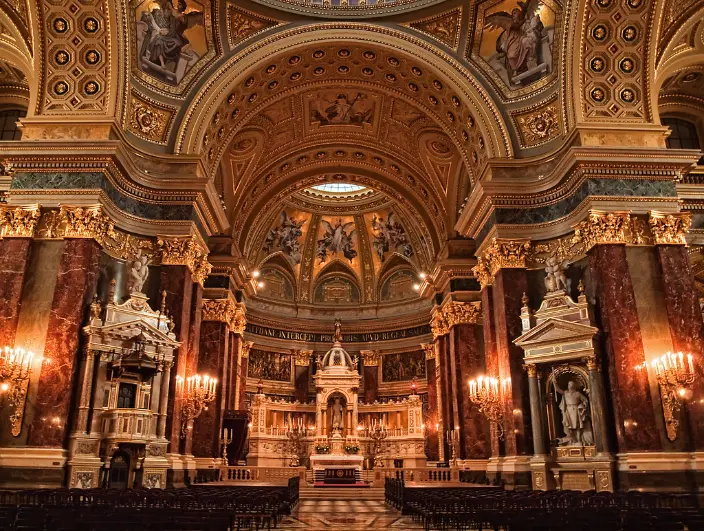
This beautiful basilica, with its Neo-Classical architecture, is one of the largest churches in Hungary and offers breathtaking panoramic views of the city from its dome.
The basilica’s interior is adorned with intricate mosaics, statues, and ornate decorations, creating a peaceful and awe-inspiring atmosphere.
It is not only a place of worship but also a cultural icon and a popular tourist destination, reflecting the city’s deep-rooted history and spiritual heritage.
Iconic Bridges and Serene Islands
Chain Bridge: Bridging the Buda-Pest Divide
The Széchenyi Chain Bridge is more than just a bridge; it stands as a symbol of unity and progress in Budapest.
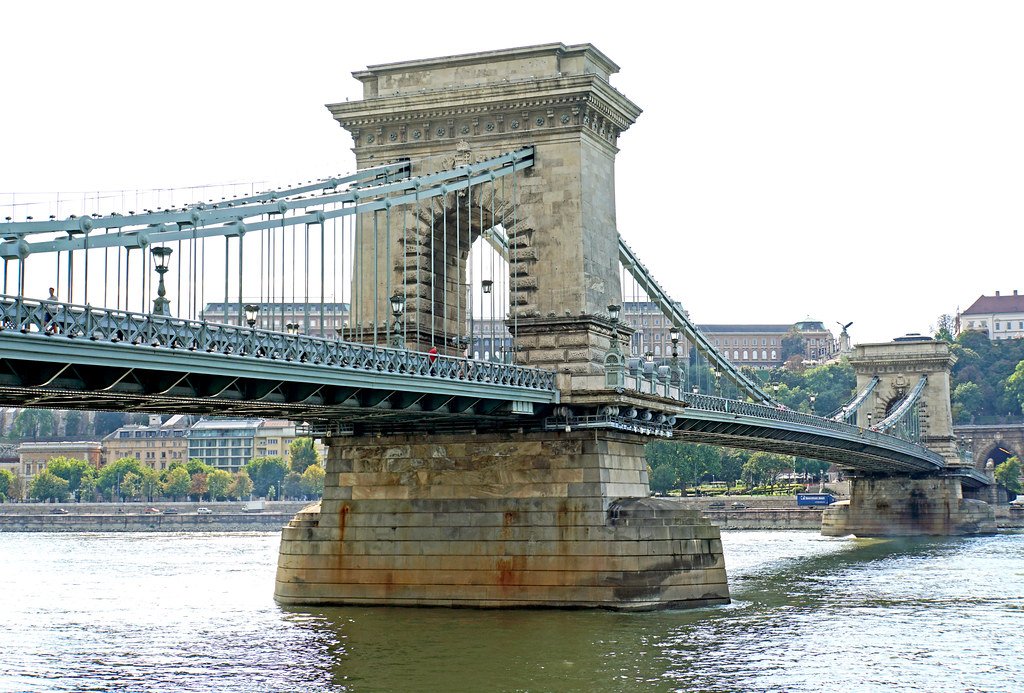
Designed by English engineer William Tierney Clark and constructed by Scottish engineer Adam Clark, this chain suspension bridge became the first permanent link between Buda and Pest, connecting the two halves of the city since its inauguration in 1849.
Its construction was a groundbreaking feat of engineering, featuring two massive stone towers and chains that support the bridge deck. The iconic lion statues at each end, sculpted by János Marschalkó, add a touch of grandeur and have become an integral part of the bridge’s identity.
The bridge has endured through various historical events, including World War II, when it was destroyed and later rebuilt, reopening in 1949. At night, the Chain Bridge is beautifully illuminated, offering a stunning view of the Danube River and the city’s skyline.
Not only does it serve as a functional thoroughfare, but it also provides a vantage point to admire Budapest’s historic landscape, including Buda Castle and the Parliament Building.
Margaret Island: An Urban Oasis
Nestled in the heart of the Danube River, Margaret Island (Margit-sziget) is a serene and picturesque oasis that offers a tranquil escape from the bustling city life of Budapest.

This 2.5-kilometer-long island is a popular recreational spot, celebrated for its lush greenery, beautiful gardens, and a variety of attractions.
Margaret Island is home to several landmarks, including the stunning St. Margaret’s Church and the remains of a 13th-century Dominican convent where Princess Margaret of Hungary once lived.
The island also features a musical fountain, a small zoo, and a botanical garden, making it an ideal destination for families and nature lovers. Its scenic walking paths, jogging trails, and bike rentals provide ample opportunities for outdoor activities.
In the evenings, the island transforms into a magical setting with its beautifully lit fountains and gardens, offering a peaceful and enchanting atmosphere for visitors to enjoy.
Whether you seek relaxation, exercise, or simply want to immerse yourself in the natural beauty of Budapest, Margaret Island is an essential stop on your itinerary.
Memorials and Museums: Gateways to the Past
Heroes’ Square: A Tribute to Hungarian Valor
Heroes’ Square, or Hősök tere, is one of the most iconic and historically significant landmarks in Budapest.

Located at the end of Andrássy Avenue and at the entrance to City Park (Városliget), this square stands as a grand tribute to the heroes of Hungarian history. The central feature of the square is the Millennium Monument, designed by Albert Schickedanz and completed in 1906.
This monument commemorates the 1000th anniversary of the Magyar conquest of the Carpathian Basin and the foundation of the Hungarian state in 896. A key highlight of the monument is the 36-meter-high column, crowned with a statue of the Archangel Gabriel, who holds the Hungarian Holy Crown and the apostolic double cross.
At the base of the column are statues of the seven Magyar chieftains, led by Árpád, who played a pivotal role in the conquest.
Behind the column, the semicircular colonnades feature statues of 14 prominent Hungarian leaders and statesmen, such as King Stephen and Lajos Kossuth. Heroes’ Square has witnessed numerous significant events, including the reburial of Imre Nagy in 1989, and continues to serve as a focal point for celebrations, ceremonies, and public gatherings.
Adding to its cultural and historical significance, the square is flanked by the Museum of Fine Arts and the Palace of Art, making it a true centerpiece of Hungarian heritage.
House of Terror: Shadows of History
The House of Terror, located on Andrássy Avenue, is a museum that explores the darker chapters of Hungary’s recent history.

This building, once the headquarters of the Arrow Cross Party and later the State Protection Authority (ÁVH), stands as a poignant reminder of Hungary’s experiences under fascist and communist regimes.
The museum’s name reflects the terror and suffering endured by the Hungarian people during these turbulent periods.
Inside, visitors will find a collection of artifacts, documents, and personal stories that shed light on the atrocities committed by these regimes. The museum’s design is deliberately stark and somber, featuring a black facade and a memorial wall outside, dedicated to the victims.
Visitors can also explore areas like the cells and interrogation rooms where political prisoners were held and tortured.
Exhibits within the museum include an in-depth look at the Hungarian Uprising of 1956 and the subsequent Soviet repression. The House of Terror is more than just a historical archive; it is a powerful tribute to those who suffered and a reminder of the enduring importance of freedom and democracy.
For anyone interested in Hungary’s complex and often turbulent past, this museum offers a somber yet essential perspective on the resilience of its people.
Baths and Parks: The Rejuvenating Soul of Budapest
Széchenyi Thermal Bath: Healing Waters
The Széchenyi Thermal Bath, located in the heart of City Park (Városliget), is one of the largest and most famous thermal baths in Europe. This iconic bath complex is a must-visit for anyone seeking relaxation and rejuvenation.
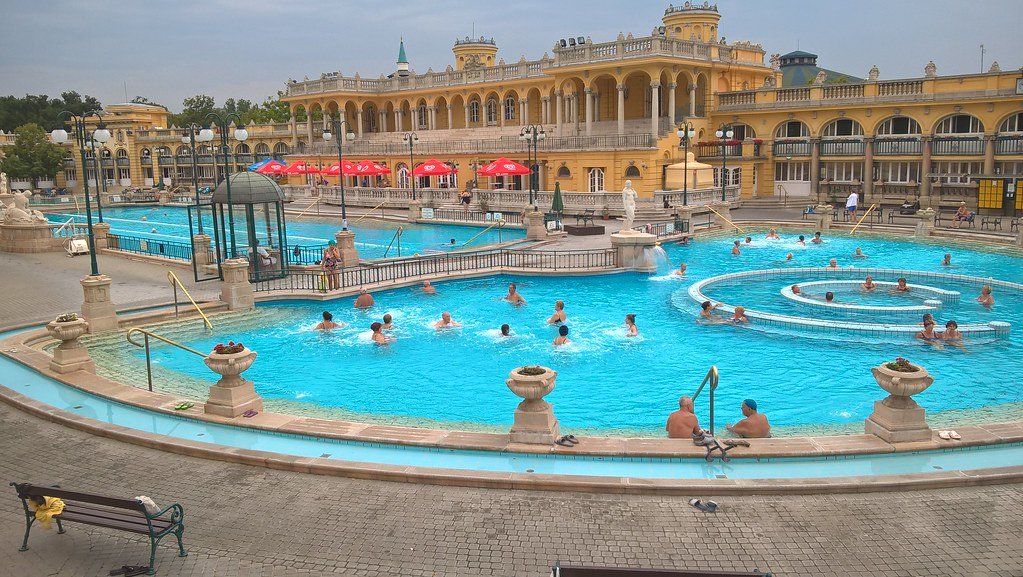
The baths are fed by two thermal springs, producing over 6 million liters of warm water daily, which is rich in minerals such as calcium, magnesium, and hydrogen carbonate.
These healing waters are believed to have therapeutic properties, making the Széchenyi Thermal Bath a popular destination for both locals and tourists alike.
The bath complex itself is a stunning example of Neo-Baroque architecture, with its grand entrance, beautifully tiled pools, and ornate details.
Visitors can enjoy a range of facilities, including indoor and outdoor pools, saunas, and massage services. The outdoor pools are particularly popular, offering a unique experience of soaking in warm waters surrounded by the picturesque scenery of City Park.
Whether you are looking to unwind after a long day of sightseeing or seeking a therapeutic escape, the Széchenyi Thermal Bath is an unparalleled experience in Budapest.
City Park: A Green Getaway
City Park (Városliget) is Budapest’s largest and most vibrant green space, serving as a tranquil oasis in the midst of the bustling city.
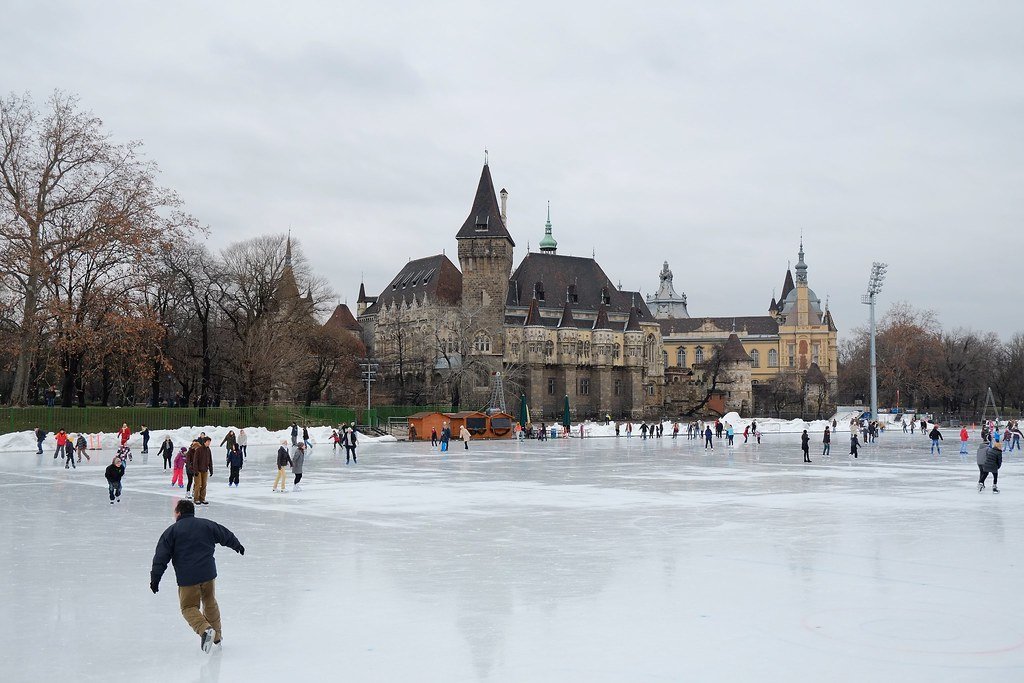
Originally a private royal hunting ground, the park was transformed into a public space during the 18th and 19th centuries, making it one of the world’s first public parks.
Spanning an area of 0.9 by 0.55 miles (1,400 by 900 meters), City Park offers a diverse array of attractions and activities for all ages.
The park is home to several notable landmarks, including Vajdahunyad Castle, which houses the Museum of Hungarian Agriculture and features a charming church.
The Budapest Zoo, one of the oldest zoos in the world, is also located within the park and boasts a wide variety of animals and remarkable buildings.
For those looking for leisure activities, the park offers a lake where you can ice-skate in winter or rent a rowing boat in summer, as well as a mini railway, a magical Ferris wheel, and a charming carousel.
City Park is also a cultural hub, with attractions like the House of Music (Magyar Zene Háza), which provides an interactive journey through Hungarian and global music history.
The park’s numerous walkways and lawns make it an ideal spot for picnics, strolls, and relaxation, ensuring that there is something for everyone to enjoy in this vibrant green getaway.
Culinary and Shopping Havens
Central Market Hall: A Feast for the Senses
The Central Market Hall, also known as the Great Market Hall, is a true culinary and cultural gem nestled in the heart of Budapest.

Situated at the end of the renowned pedestrian shopping street Váci utca and near the iconic Liberty Bridge, this market is a must-visit for anyone eager to explore the authentic flavors and traditions of Hungarian cuisine.
Designed by Hungarian architect Samu Pecz and completed in 1897, the market features stunning Neo-Gothic architecture and is crowned with vibrant Zsolnay tiles on its roof.
Inside, visitors are greeted by an impressive array of fresh produce, meats, cheeses, and traditional Hungarian specialties such as paprika, sausages, and the famous Tokaji wine.
On the ground floor, the market buzzes with vendors offering fresh fruits, vegetables, meats, and dairy products.
The basement houses a supermarket, fishmongers, and game meat vendors, while the upper floor is dedicated to souvenirs, traditional clothing, local handicrafts, and food stalls.
These stalls serve up iconic Hungarian dishes like goulash, lángos, and Wiener schnitzel, providing a taste of Hungary in a lively atmosphere.
The food stalls on the upper floor offer a unique dining experience, allowing visitors to savor authentic Hungarian cuisine amidst a vibrant and bustling setting.
Whether you’re looking to indulge in local delicacies, shop for traditional Hungarian products, or simply soak in the lively ambiance, the Central Market Hall is an essential stop on any Budapest itinerary.
Váci Street: Budapest’s Premier Shopping Boulevard
Váci Street, one of Budapest’s most famous and bustling shopping streets, is a shopper’s paradise and a hub of activity in the city’s heart.
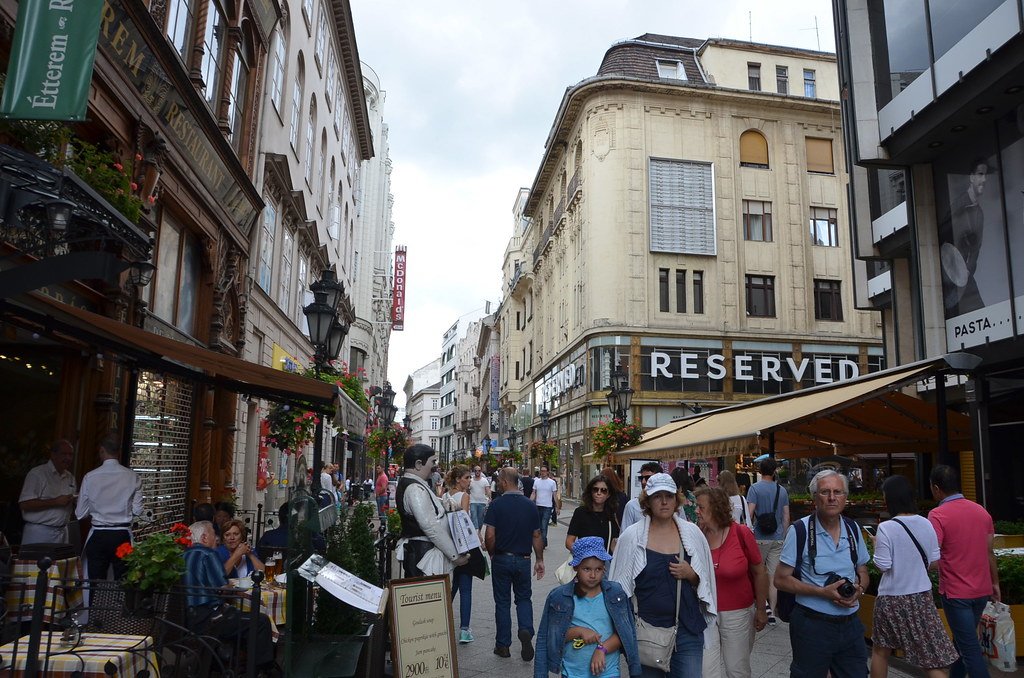
Stretching from Vörösmarty Square to the Great Market Hall, this pedestrian street in the Pest district offers a diverse range of shopping, dining, and entertainment options.
Lined with a mix of high-end boutiques, souvenir shops, cafes, and restaurants, Váci Street is the perfect destination for both locals and tourists. Its beautiful architecture, with many buildings dating back to the 19th century, adds an extra layer of charm.
Visitors can also enjoy traditional Hungarian cuisine or international dishes at the street’s numerous cafes and restaurants.
For souvenir enthusiasts, Váci Street offers a wide selection of shops selling handmade crafts, local spices, traditional clothing, and unique mementos. Its central location and easy access via public transport make it a convenient and enjoyable destination for anyone exploring Budapest’s shopping and culinary scenes.
As evening falls, Váci Street transforms into a vibrant and lively area, with street performers, live music, and beautifully illuminated buildings enhancing its magical atmosphere.
Whether you’re shopping, dining, or simply soaking in the ambiance, Váci Street captures the essence of Budapest’s urban life and culture, making it a must-visit destination.
Cultural Experiences and Nighttime Splendors
Budapest Opera House: A Night at the Opera
The Budapest Opera House, a masterpiece of neo-Renaissance architecture, offers an unparalleled cultural experience, especially in the evenings.
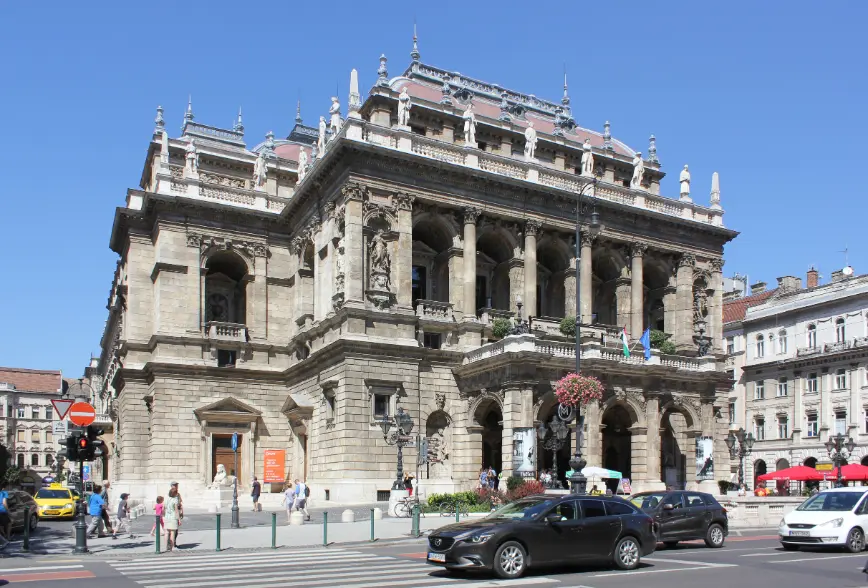
This iconic venue, home to the Hungarian State Opera, is renowned for its exquisite performances of opera, ballet, and concerts. With a rich history dating back to 1884, the opera house has hosted some of the most celebrated artists in the world, including Gustav Mahler and Otto Klemperer.
Attending a performance at the Budapest Opera House is a must for any culture enthusiast. The season, which runs from September to mid-June, features a diverse repertoire including classics like Verdi’s Aida, Mozart’s Don Giovanni, and Puccini’s Madame Butterfly.
The auditorium, with its horseshoe shape and four tiers of boxes, provides an intimate and acoustically superior setting, making every performance a memorable experience.
In addition to the main performances, the opera house also offers guided tours that include a mini-concert by artists of the Hungarian State Opera.
These tours provide a unique glimpse into the building’s stunning interior, complete with marble columns, mosaics, and frescoes by renowned Hungarian artists.
Danube Evening Cruise: Budapest by Night
A Danube Evening Cruise is a magical way to experience Budapest’s nighttime splendor. As the sun sets, the city transforms into a dazzling display of lights, with its historic landmarks and bridges illuminated against the dark sky.
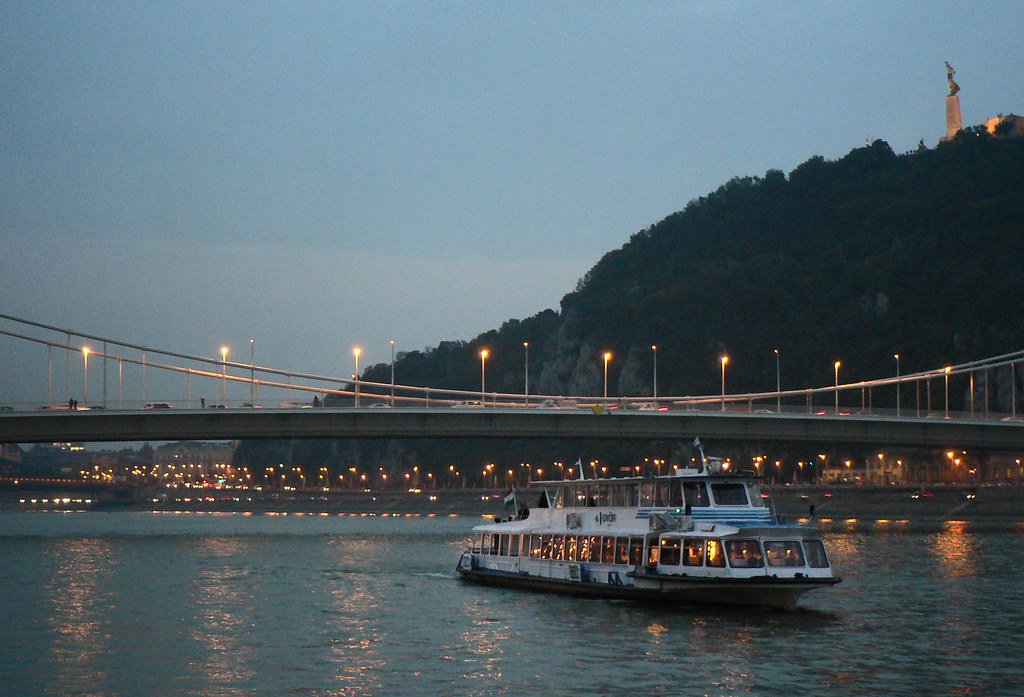
The cruise offers a serene and panoramic view of the city’s skyline, allowing you to appreciate the beauty of Budapest from a different perspective.
The cruise typically starts from the city center and takes you along the Danube River, passing by iconic landmarks such as the Parliament Building, Buda Castle, and the Chain Bridge.
The commentary provided during the cruise gives you insights into the history and significance of these landmarks, enriching your experience with stories and anecdotes about the city’s past and present.
As you glide along the river, you can enjoy the city’s vibrant nightlife, with many of its buildings and bridges beautifully lit up.
The cruise often includes live music or a buffet dinner, adding to the ambiance and making the experience even more enjoyable. Whether you are looking for a romantic evening or simply a unique way to see Budapest, a Danube Evening Cruise is an unforgettable experience that captures the essence of the city under the stars.
Conclusion
Budapest, with its rich history, stunning architecture, and vibrant cultural scene, is a city that offers something for every kind of traveler.
From the grandeur of Buda Castle and the Hungarian Parliament Building to the serene beauty of Margaret Island and the therapeutic waters of Széchenyi Thermal Bath, each landmark shares a unique story of the city’s past and present.
Whether you’re exploring the historic Castle District, strolling along the Danube Promenade, or enjoying a night at the Budapest Opera House, every experience in Budapest is truly unforgettable.
As you plan your trip, make sure to visit iconic sites like Heroes’ Square, Fisherman’s Bastion, and St. Stephen’s Basilica. Don’t miss the chance to shop and dine on Váci Street and at the Central Market Hall.
Budapest’s remarkable blend of history, culture, and natural beauty makes it a destination that will leave you enchanted and eager to return.
So, pack your bags, immerse yourself in this captivating city, and discover why Budapest is often called the “Paris of the East.”
You may also like our ultimate guide to traveling to Europe.
FAQ
What are the main attractions to see in the Castle District of Budapest?
The main attractions in the Castle District of Budapest include Buda Castle, which houses the Hungarian National Gallery and the Budapest History Museum; Fisherman’s Bastion, offering panoramic views of the city; Matthias Church, renowned for its Gothic facade and ornate interior; the Castle Hill Funicular; and the charming historic streets and squares such as Holy Trinity Square and Vienna Gate Square. Additionally, visitors can explore the Labyrinth of Buda Castle, the Sandor Palace, and enjoy stunning views of the Danube River and the Pest side of the city.
How can I get to the top of Castle Hill in Budapest?
To reach the top of Castle Hill in Budapest, you have several options:
- Walk up the steep hill from Clark Adam Square or take one of the hidden routes and stairs.
- Take bus #16, which stops near the Castle District.
- Use the Buda Hill Funicular (Sikló) departing from Clark Adam Square.
- Utilize one of the elevators or escalators located around the hill.
- Alternatively, enjoy a scenic walk across the Chain Bridge from Pest and then ascend.
What are the notable landmarks and buildings around Heroes’ Square in Budapest?
Notable landmarks and buildings around Heroes’ Square in Budapest include the Millennium Monument, featuring statues of the seven Magyar chieftains and Hungarian national heroes; the Museum of Fine Arts; the Palace of Art (Műcsarnok); and the nearby City Park (Városliget), which includes Vajdahunyad Castle. The square also houses the Memorial Stone of Heroes and marks the end of Andrássy Avenue, a UNESCO World Heritage Site.
What is the significance of the Chain Bridge in Budapest, and what makes it a popular attraction?
The Chain Bridge in Budapest holds historical significance as the first permanent bridge across the Danube, connecting Buda and Pest, and symbolizing unity, independence, and modernity. It played a key role in fostering economic growth and improving transportation. As a marvel of 19th-century engineering, its architectural grandeur, historic importance, and breathtaking views make it a must-see attraction for both locals and tourists.




